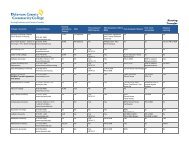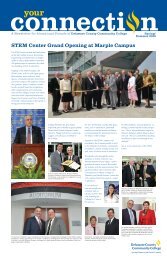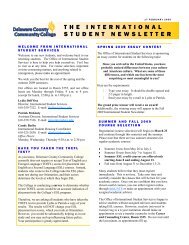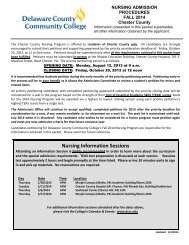2010 Catalog - Delaware County Community College
2010 Catalog - Delaware County Community College
2010 Catalog - Delaware County Community College
You also want an ePaper? Increase the reach of your titles
YUMPU automatically turns print PDFs into web optimized ePapers that Google loves.
COURSE DESCRIPTIONS 169<br />
• Create E6010 and E6011 fillet welds in flat and<br />
horizontal positions.<br />
Prereq. WLD 105<br />
2 Credits 1 Weekly Lecture Hours<br />
2 Weekly Laboratory Hours<br />
WLD 150<br />
Welding Design<br />
This course emphasizes the use of basic drafting skills<br />
for lay out of plate steel sheet metal, and patterns and<br />
the selection of welding processes and joint design.<br />
Students will calculate and estimate weldment and weld<br />
metal, and will learn how to allow for distortion and the<br />
use of jigs, fixtures and positioners.<br />
Upon successful completion of this course, students<br />
should be able to:<br />
• Calculate material costs.<br />
• Use fixtures and jigs for design purposes.<br />
Prereq. WLD 202<br />
2 Credits 1 Weekly Lecture Hours<br />
2 Weekly Laboratory Hours<br />
WLD 151 Testing and Inspection of Welds<br />
This course introduces the principles and applications<br />
of non destructive testing using liquid penetrant,<br />
magnetic particles, and ultrasonic and radiographic<br />
testing methods. Emphasis is placed on non-destructive<br />
procedures and interpretation of code specifications and<br />
standards.<br />
Upon successful completion of this course, students<br />
should be able to:<br />
• Cite the principles of non-destructive testing.<br />
• Explain the use of liquid penetrant, mag positive and<br />
ultrasonic and radiographic testing.<br />
• Work with welding and safety codes and standards.<br />
2 Credits 1 Weekly Lecture Hours<br />
2 Weekly Laboratory Hours<br />
WLD 152<br />
Welding Codes and<br />
Specifications<br />
This course covers welding codes and their applications.<br />
Upon successful completion of this course, the student<br />
should be able to:<br />
• Explain welding codes and their use.<br />
• Use welding specifications.<br />
• Apply proper use of A.P.I., A W.S., and A.M.E. codes.<br />
• Describe, in basic terms, the various considerations<br />
associated with special purpose machines, processes,<br />
mass production, hard and soft automation, and<br />
assembly techniques.<br />
2 Credits 1 Weekly Lecture Hours<br />
2 Weekly Laboratory Hours<br />
WLD 153 Soldering, Brazing and<br />
Brace Welding<br />
This course discusses the advantages of soldering<br />
and brazing. Soldering and brazing methods including<br />
building up surfaces filling holes filler metals and fluxes<br />
are covered.<br />
Upon successful completion of this course students<br />
should be able to:<br />
• Explain the use of soldering and brazing.<br />
• Use methods involved in soldering and brazing.<br />
• Demonstrate basic soldering and brazing of varied<br />
joint designs.<br />
2 Credits 1 Weekly Lecture Hours<br />
2 Weekly Laboratory Hours<br />
WLD 200<br />
Gas Metal Arc I<br />
This course covers GMAW equipment set-up and<br />
operation. The theory of gas metal arc welding is applied<br />
to mild steel and plate steel in all positions. Students are<br />
introduced to single and multi phase welds using a<br />
variety of electrode (wire) diameters.<br />
Upon successful completion of this course, students<br />
should be able to:<br />
• Explain GMAW as applied to nonferrous metals.<br />
• Demonstrate different modes of metal transfer.<br />
• Practice welding sheet and plate steel in all positions.<br />
2 Credits 1 Weekly Lecture Hours<br />
2 Weekly Laboratory Hours<br />
WLD 201<br />
Gas Metal Arc II<br />
This course covers the application of gas metal arc<br />
welding theory to non-ferrous materials and their alloys.<br />
Different modes of metal transfer are addressed.<br />
Upon successful completion of this course, students<br />
should be able to:<br />
• Show proper GMAW equipment set-up.<br />
• Demonstrate threading GMAW wire.<br />
• State how to set appropriate gas flow rate and current.<br />
• Describe the various methods of metal transfer.<br />
• Explain the effect of slope and inductance in gas metal<br />
arc welding.<br />
• Perform welds in all positions using the short-circuiting<br />
metal transfer method.<br />
• Weld in the IF, 2F and IG positions using the globular<br />
metal transfer method.<br />
• Perform welds in the IF and IG positions using the axial<br />
spray metal transfer method.<br />
2 Credits 1 Weekly Lecture Hours<br />
2 Weekly Laboratory Hours<br />
WLD 202<br />
Advanced Shielded Arc I<br />
The advanced shielded metal arc course continues the<br />
theory covered in Shielded Metal Arc Welding II. A variety<br />
of electrodes are discussed. The American Welding<br />
Society (A.W.S.) numbering system is emphasized.<br />
Specifications of A.S.M.E., A.S.T.M. and A.P.I codes are<br />
covered. Students learn mild steel with E6010 in all<br />
positions. Students will learn A.W.S. welding symbols<br />
and how they are used.<br />
Upon successful completion of this course, students<br />
should be able to:<br />
• Depict the variety of electrodes in SMAW and their uses.<br />
• Explain the A.W.S. numbering system.<br />
• Work with A.S.M.E., A.S.T.M. and A.P.I. codes.<br />
• Weld with E6010 on heavy plate in all positions.<br />
Prereq. WLD 106<br />
2 Credits 1 Weekly Lecture Hours<br />
2 Weekly Laboratory Hours<br />
WLD 203<br />
Advanced Shielded Arc II<br />
Students practice all positions, applications and<br />
weldments to the specifications of A.W.S., A.S.M.E., A<br />
S.T.M. and A.P.I. codes. Also covered is blueprint reading<br />
for welding and its uses. Students test welds using nondestructive<br />
tests.<br />
Upon successful completion of the course, students<br />
should be able to:<br />
• Weld in all positions using a variety of electrodes.<br />
• Weld in accordance with A.W.S., A S.M.E., A S.T.M. and<br />
A.P.I. specifications.<br />
• Interpret welding blueprints.<br />
• Perform non-destructive testing procedures.<br />
Prereq. WLD 202<br />
2 Credits 1 Weekly Lecture Hours<br />
2 Weekly Laboratory Hours<br />
WLD 204<br />
Gas Tungsten Arc I<br />
This course emphasizes the set up and operation of<br />
the GTAW process. Various types of tungsten electrodes<br />
are covered, along with tolerances and color codes.<br />
Welding machines and polar lines that are commonly<br />
used are discussed.<br />
Upon successful completion of this course, students<br />
should be able to:<br />
• Differentiate GTAW welding equipment.<br />
• Set up and operate GTAW equipment for welding.<br />
• List the types of tungsten and their uses.<br />
• Depict the different torches used in GTAW.<br />
• Explain the polarities used in GTAW processes.<br />
Prereq. WLD 203<br />
2 Credits 1 Weekly Lecture Hours<br />
2 Weekly Laboratory Hours<br />
WLD 205<br />
Gas Tungsten Arc II<br />
Gas tungsten arc welding is covered in various positions,<br />
using ferrous and non-ferrous sheet and plate. Different<br />
welding gases are also used with GTAW processes.<br />
Upon successful completion of this course, students<br />
should be able to:<br />
• Perform gas tungsten arc weld in various positions.<br />
• Use different welding gases in the GTAW process.<br />
• Demonstrate gas tungsten arc weld on ferrous and<br />
non-ferrous metals.<br />
Prereq. WLD 204<br />
2 Credits 1 Weekly Lecture Hours<br />
2 Weekly Laboratory Hours

















